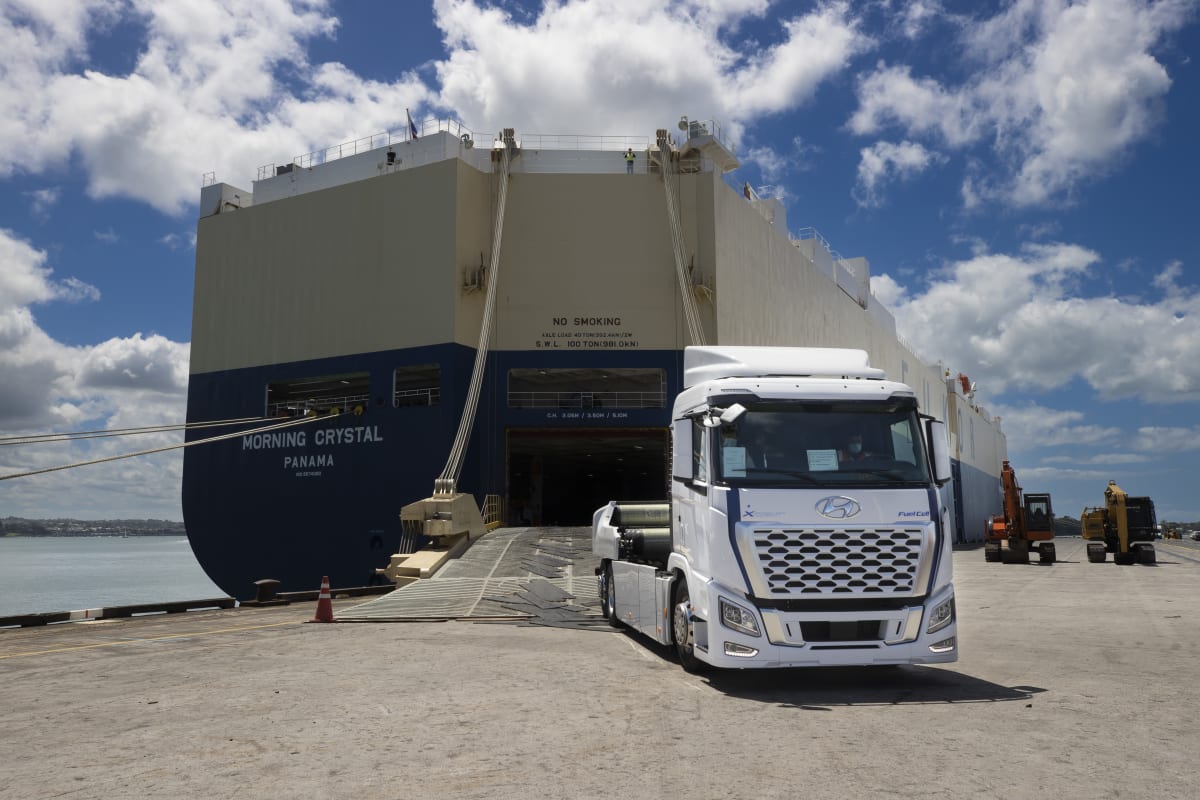
The rising cost of petrol and diesel is fuelling inflation and quickly making new technologies more attractive. Hyundai NZ CEO Andy Sinclair explains why hydrogen-powered trucks can have a major impact on our transport industry | Content Partnership
Zero emission cars are now commonplace on our roads. But this year they’ll be joined by zero emission hydrogen-powered trucks for the first time.
That’s important because although heavy trucks represent only about 4% of all the vehicles in New Zealand, they contribute nearly 25% of all carbon emissions from road transport. We must reduce these emissions to meet our international climate change obligations.
The reason trucks contribute disproportionately more road emissions is not because trucks are largely fuelled by diesel. Diesel fuel contains slightly more carbon than petrol, but overall CO2 emissions tend to be lower.
They contribute more emissions because most trucks are on the road almost every day. To maximise efficiency and get the most out of their asset, each business maximises their time on the road.
The consensus is that we will reduce climate-changing emissions and other pollutants by switching transport away from the internal combustion engine. By now we’re all very familiar with the alternatives of electric vehicles and hybrid electric-combustion formats.
Compared with the Herculean task of changing the 4 million passenger vehicles to electric vehicles, we only need to change out 153,000 trucks.
The challenge is that trucks are used very differently to passenger cars. Electric motors can power most trucks but it’s the batteries that make things problematic.
Cars spend a lot of time garaged or parked, and make much shorter trips on average. Electric batteries are easily able to meet that need. Vehicles can cover about 300km on a charge, but some can reach over 600km. Recharging time varies per model and depends on how the car is being charged. For most it generally just means the minor inconvenience of plugging it in overnight.
Trucks are driven all day, every day. There’s more than 23,000 freight fleets, and these run even more often, including overnight. Taking multiple hours out to recharge regularly is time the truck can’t be on the road.
Trucks also go long distances, every day, carrying a lot of weight. Vehicle weight reduces distance by consuming more battery charge – just like it does consumption of diesel and petrol. As a result, electric trucks need to carry a lot of batteries to cover the standard distances. But batteries themselves add weight that increases energy consumption and reduces the payload.

Trucks need reliability. They need to travel route and schedules consistently. The variety of road and weather conditions in New Zealand can vary battery performance beyond what is tolerable or practical for running freight.
One answer is to power electric batteries with a different energy source. That’s where hydrogen comes in.
Hydrogen vehicles make their own electricity and supply it to the motor. The Hydrogen gas is stored in thick walled, safety-sealed tanks behind the cab before being supplied to the fuel cell. Inside the cell, an electro-chemical reaction separates electrons from the hydrogen atoms. It’s the movement of these electrons that generates electricity.
This electricity charges a smaller lithium polymer storage battery, which then powers an electric drivetrain that turns the motor. Once the separated electron meets back with the hydrogen atom, it combines with the air to produce water, which evaporates.
The nation’s first zero emission hydrogen-fuelled electric truck arrived in late November. Hyundai New Zealand has bought five XCIENT FCEV (fuel cell electric vehicle) trucks, with the help of some funding from the Energy Efficiency and Conservation Authority, and using the fuel cell technology developed by the Hyundai Motor Company from Korea.
New Zealand will be one of the first three countries in the world to run hydrogen trucks in fully commercial daily operations with freight operators (along with Korea and Switzerland). At the start of commercial operations, the trucks will be fuelled by their own hydrogen refueller until the first group of hydrogen-refuelling stations are built.
For the engine nerds out there, the XCIENT is powered by a 350kw electric motor with 2237Nm of torque. It has a range of about 400km – the driving distance between Auckland and Palmerston North.
New Zealand is now at the forefront of international efforts to shift heavy vehicle transport to zero emission formats. Each XCIENT on our road in place of a diesel truck will save 50 tonnes of CO2 a year from being emitted into our environment.
The difference from diesel trucks is instantly noticeable to experienced drivers. They are almost as quiet as their passenger car peers, with no loud engine noises.
There are two other fascinating technologies. A special filter is required to clean the air that goes into the engine. In a neat twist, it ends up removing particulates belched into the environment by diesel trucks on the road alongside the XCIENT. The other technology is an artificial engine-sound generator. The truck is so quiet at low speeds that the sound is needed as a safety precaution.
It is possible that you’ll see these trucks on the road this year. Give the driver a wave. You’ll both be experiencing what the clean transport future looks, sounds, and smells like.







